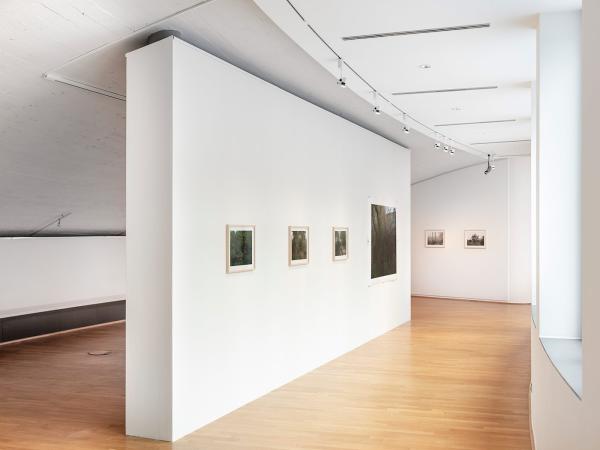rest und reservoir
D:
Mit rest und reservoir thematisiert Matthias Klos urbane Bodenversiegelung und befragt unsere kulturtechnologischen Formatierungen von Boden und Zeit sowie die sich daran anschließenden Verwertungen. Die Arbeit besteht aus einem subjektiven fotografischen Kompendium urbaner Natur auf Brachflächen der Städte Berlin und Wien sowie einem Text, in dem der Künstler die Wechsewirkungen zwischen Boden und Zeit über Epochen, Katastergrenzen und Vegetationsräume hinweg verfolgt.
Die Fotografien der brachen Parzellen repräsentieren – als visueller Anker – die konkreten Optionen, eine nicht vermehrbare Ressource wie Boden entweder zu verbrauchen, oder sie als räumliches, zeitliches wie ökologisches Reservoir im städtischen Raum zu verstehen. Über die Titel der Aufnahmen, bestehend aus den Städtenamen und Flurstückkennzeichnungen, sind die portraitierten Areale mit den Katasterordnungen verknüpft. Dies verbindet sie direkt mit den jeweiligen städtebaulichen Widmungsplänen, die eine künftige bauliche Verwertung regeln.
Technologie, Geschichte, Urban Exploring und Archivbestände schichtet Matthias Klos in einer großformatigen, 12-seitigen Edition zu einem assoziativen Pfad durch die Ein- und Unterteilungen von Boden und Zeit. In dieser textlichen Erkundung verweben sich Zitate, Berichte, Short-Stories und Artefakte, um die Verbundenheit von Boden und Zeit zu erkunden.
Die Edition liegt in der Ausstellung zur freien Entnahme auf.
E:
With rest and reservoir Matthias Klos questions our cultural-technological formatting of soil and time as well as the subsequent uses. The work consists of a subjective photographic compendium of urban nature on fallow land in the cities of Berlin and Vienna, as well as a text in which the artist traces the effects of change between soil and time across epochs, cadastral boundaries and vegetation spaces.
The photographs of the fallow plots represent—as a visual anchor—the concrete options of either consuming a non-replicable resource such as soil, or of understanding it as a spatial, temporal and ecological reservoir in urban space. Through the titles of the photographs, consisting of the city names and parcel markings, the portrayed areas are linked to the cadastral regulations. This connects them directly with the respective urban zoning plans, which regulate future construction exploitation.
In a large-format, 12-page edition, Matthias Klos layers technology, history, urban exploring and archive holdings into an associative path through the subdivisions of soil and time. In this textual exploration, quotations, reports, short stories and artifacts interweave to explore the interconnectedness of soil and time.
The edition is in the exhibition for free collection.
• in Kooperation mit:
Österreichisches Kulturforum Berlin

• Dieses Projekt entstand im Rahmen des ONTHEROADAGAIN-Call der Sektion für internationale Kulturangelegenheiten im Außenministerium und der Österreichischen Kulturforen in Kooperation mit der Künstlerhaus Vereinigung Wien



![rest und reservoir [Wien, Favoriten (01 101) 1435/46]](../html/img/thumbs/m__MK_IMG5829.jpg)
![rest und reservoir [Berlin, Tiergarten 11000200804106]](../html/img/thumbs/m_MK_IMG8861.jpg)
![rest und reservoir [Wien, Simmering (01107) 1256/5]](../html/img/thumbs/m_M_K_IMG5707.jpg)
![rest und reservoir [Berlin, Pankow 11056016200126]](../html/img/thumbs/m_B_MK_IMG8426.jpg)
![rest und reservoir [Wien, Oberlaa Stadt (01 105) 1237/2]](../html/img/thumbs/m_MK_IMG5766.jpg)
![rest und reservoir [Berlin, Friedrichshain 1100050190050]](../html/img/thumbs/m_MK_IMG8927.jpg)
![rest und reservoir [Wien, Oberlaa Stadt (01105) 1238/4]](../html/img/thumbs/m_MK_IMG5772.jpg)
![rest und reservoir [Berlin, Friedrichshain 11000501900501]](../html/img/thumbs/m_MK_IMG8806.jpg)
![rest und reservoir [Wien, Großjedlersdorf II (01 607) 1005/1]](../html/img/thumbs/m_MK_IMG5515.jpg)
![rest und reservoir [Berlin, Weißensee 110054526400217]](../html/img/thumbs/m_MK_IMG8380.jpg)
![rest und reservoir [Wien, Donaufeld (01603) 1508/2]](../html/img/thumbs/m_B_MK_A_IMG7091.jpg)
![rest und reservoir [Berlin, Weißensee 11054526400026]](../html/img/thumbs/m_B_MK_IMG8411_b.jpg)
![rest und reservoir [Wien, Stadlau (01 665) 167/25]](../html/img/thumbs/m_MK_IMG5572.jpg)
![rest und reservoir [Berlin, Weißensee 11054525704400]](../html/img/thumbs/m_MK_IMG8574.jpg)
![rest und reservoir [Wien, Großjedlersdorf II (01607) 22/1]](../html/img/thumbs/m_MK_IMG5476_.jpg)
![rest und reservoir [Wien, Oberlaa Stadt (01105) 1237/1]](../html/img/thumbs/m_MK_IMG5782_.jpg)





